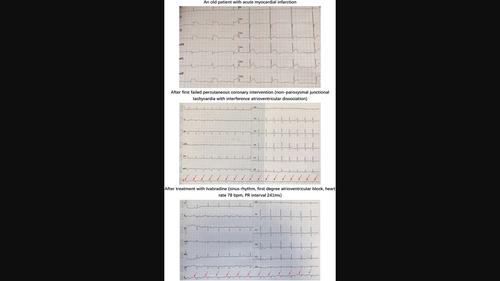当前位置:
X-MOL 学术
›
Ann. Noninvasive Electrocardiol.
›
论文详情
Our official English website, www.x-mol.net, welcomes your
feedback! (Note: you will need to create a separate account there.)
Ivabradine in the treatment of non-paroxysmal junctional tachycardia with interference atrioventricular dissociation: A case report
Annals of Noninvasive Electrocardiology ( IF 1.1 ) Pub Date : 2023-05-08 , DOI: 10.1111/anec.13064 Shuo Ying 1 , Jing Zhang 1 , Nai-Kuan Fu 1 , Peng Zhang 1
Annals of Noninvasive Electrocardiology ( IF 1.1 ) Pub Date : 2023-05-08 , DOI: 10.1111/anec.13064 Shuo Ying 1 , Jing Zhang 1 , Nai-Kuan Fu 1 , Peng Zhang 1
Affiliation

|
Ivabradine reduces the heart rate by selectively inhibiting the If current of the sinoatrial node, mainly for the treatment of chronic heart failure with decreased left ventricular systolic function and inappropriate sinus tachycardia, but the inhibitory effect on the atrioventricular node is rarely reported. The patient was admitted to hospital mainly because of intermittent chest pain for 7 years, which worsened for 10 days. Admission electrocardiogram (ECG) considered sinus tachycardia, with QS wave and T wave inversion in II, III, aVF, V3R-V5R, V4–V9 leads, and non-paroxysmal junctional tachycardia (NPJT) with interference atrioventricular dissociation. After treatment with ivabradine the ECG returned to normal conduction sequence. NPJT with interference atrioventricular dissociation is a fairly rare electrocardiographic phenomenon. This case reports for the first time that ivabradine is used in the treatment of NPJT with interference atrioventricular dissociation. It is speculated that ivabradine has a potential inhibitory effect on the atrioventricular node.
中文翻译:

伊伐布雷定治疗干扰性房室分离非阵发性交界性心动过速一例
伊伐布雷定通过选择性抑制窦房结I f 电流来降低心率,主要用于治疗左室收缩功能下降的慢性心力衰竭和不适当的窦性心动过速,但对房室结的抑制作用鲜有报道。患者入院主要因间歇性胸痛7年,加重10天。入院心电图(ECG)考虑窦性心动过速,II、III、aVF、V 3 R-V 5 R、V 4 –V 9出现 QS 波和 T 波倒置导联和非阵发性交界性心动过速 (NPJT) 干扰房室分离。伊伐布雷定治疗后心电图恢复正常传导序列。NPJT 干扰房室分离是一种相当罕见的心电图现象。本病例首次报道伊伐布雷定治疗干扰房室分离的NPJT。推测伊伐布雷定对房室结具有潜在的抑制作用。
更新日期:2023-05-08
中文翻译:

伊伐布雷定治疗干扰性房室分离非阵发性交界性心动过速一例
伊伐布雷定通过选择性抑制窦房结I f 电流来降低心率,主要用于治疗左室收缩功能下降的慢性心力衰竭和不适当的窦性心动过速,但对房室结的抑制作用鲜有报道。患者入院主要因间歇性胸痛7年,加重10天。入院心电图(ECG)考虑窦性心动过速,II、III、aVF、V 3 R-V 5 R、V 4 –V 9出现 QS 波和 T 波倒置导联和非阵发性交界性心动过速 (NPJT) 干扰房室分离。伊伐布雷定治疗后心电图恢复正常传导序列。NPJT 干扰房室分离是一种相当罕见的心电图现象。本病例首次报道伊伐布雷定治疗干扰房室分离的NPJT。推测伊伐布雷定对房室结具有潜在的抑制作用。











































 京公网安备 11010802027423号
京公网安备 11010802027423号